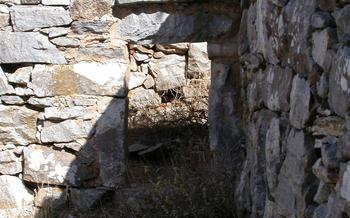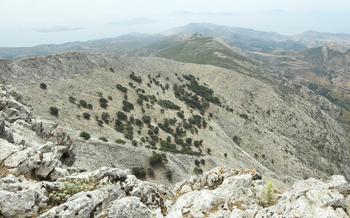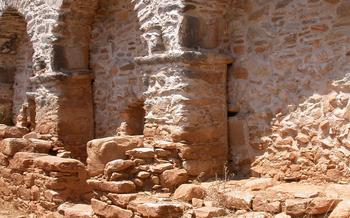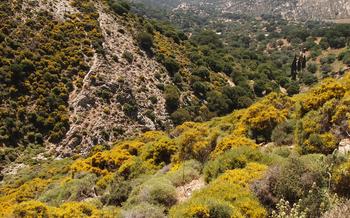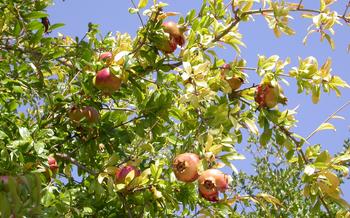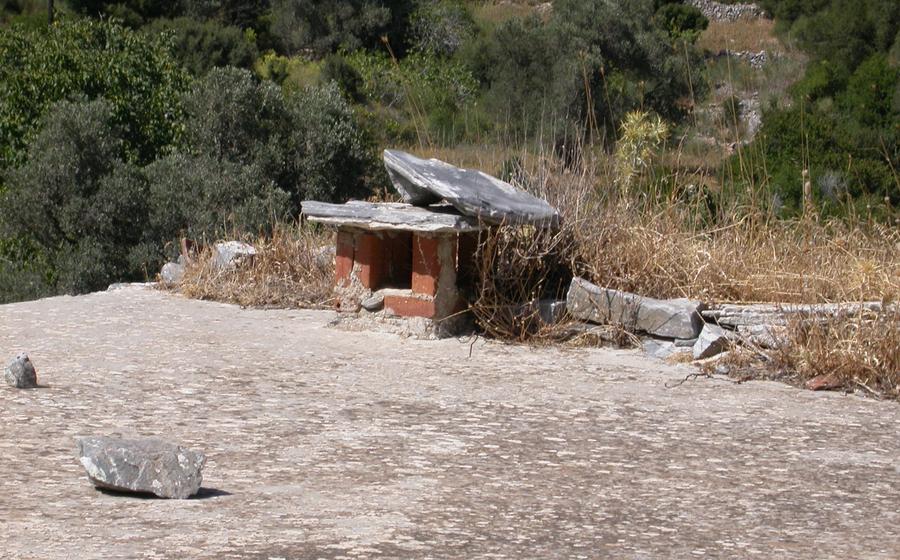
The Church of Panagia Theoskepasti in Komiaki
- The Church of Panagia Theoskepasti: History and Background
- Location
- Interior Beauty
- Unique Architectural Features
- Panoramic Views
- Religious Significance
- Cultural Importance
- Historical Events
- Pilgrimage Site
- Restoration Efforts
- Local Festivals and Celebrations
- Accessibility
- Visiting Tips
- Nearby Attractions
- Insider Tip: Unlocking the Secrets of the Church's Cryptic Inscription
The Church of Panagia Theoskepasti: History and Background
Nestled in the picturesque village of Komiaki, the Church of Panagia Theoskepasti stands as a testament to Naxos's rich history and religious heritage. Its origins can be traced back to the Byzantine period, when the island was under Venetian rule. Legend has it that the church was miraculously constructed in a single night by angels, who transported the building stones from a nearby quarry.
The architectural style of the church reflects the transition from the Byzantine to the Venetian period, showcasing a harmonious blend of both influences. Its cultural significance lies in its representation of Naxos's deep-rooted religious traditions and its connection to the Greek Orthodox faith. The church is dedicated to the Virgin Mary, locally known as Panagia Theoskepasti, and is revered by the local community as a sacred site.
Location
Nestled within the picturesque village of Komiaki, on the alluring island of Naxos, stands the enchanting Church of Panagia Theoskepasti. This sacred edifice can be found at the village's heart, seamlessly blending into the traditional architecture that defines Komiaki's streetscape. The church's precise address is Komiaki 843 00, Naxos, Greece, making it easily accessible for pilgrims and visitors alike.
Accessibility to the church is a breeze, thanks to the well-maintained roads that connect Komiaki to the rest of the island. Whether you choose to navigate the charming village on foot, marveling at its traditional houses adorned with vibrant bougainvillea, or opt for the convenience of a vehicle, the journey to this sacred site is a delightful experience in itself.
The Church of Panagia Theoskepasti's prime location offers not only spiritual tranquility but also proximity to other captivating attractions. A mere stone's throw away, visitors can immerse themselves in the fascinating history of Naxos at the nearby Archaeological Museum. The museum houses a captivating collection of artifacts that narrate the island's rich past, from ancient civilizations to Byzantine and Venetian rule.
Moreover, the church's idyllic setting grants visitors stunning views of the surrounding landscape. Overlooking the picturesque village of Komiaki, the church's elevated position offers panoramic vistas of the verdant Naxos countryside, where olive groves, vineyards, and citrus trees create a tapestry of colors. As the sun begins its descent, the church transforms into a magical vantage point to witness the mesmerizing sunsets that bathe the horizon in hues of gold and crimson.
Interior Beauty
Beyond its striking exterior, the Church of Panagia Theoskepasti boasts an awe-inspiring interior that captivates the senses. Step inside, and you'll be greeted by a symphony of Byzantine art and architecture. The walls are adorned with intricate frescoes and iconography, each telling a story from the Bible or the life of the Virgin Mary. The ceiling is adorned with shimmering Byzantine-style mosaics, adding a touch of grandeur to the sacred space.
One of the most striking features of the church's interior is its unique wooden iconostasis. This intricately carved screen separates the sanctuary from the nave and features a collection of icons depicting various saints and biblical figures. The craftsmanship and attention to detail are simply breathtaking, showcasing the skill and devotion of the artisans who created it.
The overall ambiance of the church is one of serenity and peace. The soft light filtering through the stained-glass windows casts a warm glow on the interior, creating a contemplative atmosphere that invites visitors to pause and reflect on the spiritual significance of this sacred space.
Unique Architectural Features
The Church of Panagia Theoskepasti boasts several distinctive architectural features that contribute to its visual appeal and historical significance.
The most striking element is its domed roof, a common feature in Byzantine architecture. The dome, supported by four massive pillars, creates a sense of grandeur and majesty within the church. Its intricate design and the vibrant frescoes adorning its interior make it a true masterpiece of Byzantine craftsmanship.
Another notable feature is the bell tower, which stands tall and elegant beside the church. Its arched openings and ornate carvings add a touch of grace to the overall structure. The bell tower serves as a beacon, guiding visitors to the church and summoning the faithful for prayer.
The arched entrances to the church are another testament to its Byzantine origins. These grand arches, supported by sturdy columns, create a sense of welcome and invite visitors to step inside and explore the sacred space.
Finally, the intricate stone carvings that adorn the exterior of the church add to its charm and visual interest. These carvings depict various religious motifs and scenes from the Bible, showcasing the skill and artistry of the craftsmen who built this remarkable edifice.
Panoramic Views
The Church of Panagia Theoskepasti commands a privileged location, offering visitors a captivating panorama that unfolds like a living painting. From the church's elevated position, the Aegean Sea stretches out like an azure tapestry, its shimmering surface reflecting the vibrant Greek sunlight. The tranquil waters cradle the neighboring islands, each a silhouette of beauty against the horizon.
To the north, the majestic Mount Zas, the highest peak of Naxos, stands sentinel, its forested slopes a verdant contrast to the shimmering sea. Southward, the village of Komiaki nestles amidst a patchwork of fertile vineyards and olive groves, the verdant hues creating a vibrant tapestry that stretches to meet the sea.
The sunsets from the church's vantage point are legendary. As the sun descends towards the horizon, the sky transforms into a canvas of fiery hues, painting the heavens with shades of crimson, gold, and purple. The silhouette of the church, bathed in this ethereal light, seems to float amidst the celestial spectacle, creating a moment of awe and wonder that lingers long in the memory.
Religious Significance
The Church of Panagia Theoskepasti holds immense religious significance in the hearts of the local community and beyond. Dedicated to the Virgin Mary, the church is a sacred site for Greek Orthodox Christians who venerate her icon with deep devotion. The icon, believed to possess miraculous powers, is a central figure of worship and a source of spiritual solace for many.
Throughout the year, the church plays host to various religious festivals and events that draw pilgrims and visitors from near and far. The most significant of these is the annual celebration of the Assumption of the Virgin Mary on August 15th. During this time, the church transforms into a vibrant hub of activity, with processions, prayers, and traditional festivities taking place in honor of the Virgin Mary.
The church's sacred atmosphere is palpable, inviting visitors to pause, reflect, and connect with their spiritual side. Whether seeking solace, guidance, or simply a moment of tranquility, the Church of Panagia Theoskepasti provides a sanctuary for those seeking divine inspiration.
Cultural Importance
The Church of Panagia Theoskepasti holds immense cultural significance in the island of Naxos, deeply intertwined with local traditions and religious practices. It embodies the spirit of Greek Orthodox Christianity, serving as a testament to the profound faith and devotion of the local community.
The church has been an integral part of Naxos's cultural history for centuries, contributing to the island's rich religious heritage. It is not merely a place of worship; it is a symbol of the island's identity and cultural pride, deeply embedded in the hearts of the local population.
As a representation of Naxos's religious architecture, the Church of Panagia Theoskepasti showcases the island's unique artistic expression and architectural traditions. Its distinctive design, intricate iconography, and serene ambiance reflect the cultural values and beliefs of the people of Naxos.
The church's enduring significance extends beyond its religious and historical value; it also serves as a gathering place for the community, fostering social cohesion and strengthening the bonds among the islanders. It is a place where traditions are preserved, celebrated, and passed down through generations.
Historical Events
The Church of Panagia Theoskepasti has witnessed and played a role in various historical events throughout the centuries. According to local legends, during the Venetian rule of Naxos, the church was miraculously protected from a devastating fire that swept through the village. The icon of the Virgin Mary is believed to have intervened, saving the church and the surrounding area from destruction.
In the 19th century, the church served as a refuge for locals during a period of political unrest and turmoil. The villagers sought solace and protection within its sacred walls, praying for peace and guidance. The church's serene ambiance and spiritual atmosphere provided comfort and strength to the community during challenging times.
The church also holds significance during World War II. It is said that the icon of Panagia Theoskepasti miraculously protected the village from enemy attacks. The locals believed that the Virgin Mary's intervention shielded them from harm, and they remain grateful for her divine protection.
Over the years, the church has witnessed numerous weddings, baptisms, and other religious ceremonies, marking important milestones in the lives of the faithful. These events have added to the rich history and cultural heritage of the Church of Panagia Theoskepasti, making it a cherished landmark for generations of Naxians.
Pilgrimage Site
The Church of Panagia Theoskepasti holds a profound significance as a pilgrimage destination for devout Greek Orthodox believers. The renowned icon of Panagia Theoskepasti, revered for its miraculous powers, draws countless pilgrims throughout the year, seeking spiritual solace and divine intervention. Every August, the church becomes the epicenter of a grand religious festival, attracting pilgrims from near and far to celebrate the feast day of the Virgin Mary with heartfelt prayers, processions, and traditional ceremonies. Pilgrims partake in special rituals, such as lighting candles, leaving offerings, and touching the icon with reverence, seeking blessings and guidance. The spiritual atmosphere that permeates the church during these festivals is palpable, creating a profound and emotional experience for pilgrims of all ages.
Restoration Efforts
The Church of Panagia Theoskepasti has undergone several restoration and conservation projects throughout its history to preserve its architectural integrity and religious significance. In the early 20th century, the church underwent a major renovation that involved reinforcing its structure, repairing damaged frescoes, and restoring the wooden iconostasis to its original glory.
One of the most significant restoration projects took place in the 1980s when the church's exterior was cleaned and restored, revealing intricate stone carvings and architectural details that had been obscured over time. This project also involved repairing the bell tower and replacing the roof tiles to ensure the church's longevity.
In recent years, the local community has played a crucial role in preserving the church's heritage. Through fundraising efforts and volunteer work, they have contributed to ongoing maintenance and conservation projects. Their dedication to preserving this sacred site ensures that it remains a beacon of spiritual and cultural significance for generations to come.
The restoration efforts undertaken at the Church of Panagia Theoskepasti exemplify the importance of preserving cultural heritage and religious architecture. By safeguarding this historic landmark, the community not only ensures its physical preservation but also protects the intangible cultural values and spiritual traditions associated with it.
Local Festivals and Celebrations
The Church of Panagia Theoskepasti is not only a religious site but also a central location for vibrant local festivals and celebrations. Throughout the year, the church grounds transform into a hub of cultural activities that showcase the rich traditions of Naxos.
One of the most significant events is the annual Panagia Theoskepasti Festival, held on August 15th, the day of the church's patron saint. Thousands of pilgrims and locals gather to celebrate with religious processions, traditional music and dance performances, and a grand feast. The atmosphere is electric, filled with the sounds of music, laughter, and the enticing aromas of Greek cuisine.
The church also hosts traditional Greek weddings, where couples exchange vows in the presence of their loved ones and the divine blessings of Panagia Theoskepasti. The church's serene ambiance and stunning views provide a picturesque backdrop for these special occasions.
During the summer months, the church grounds host cultural events and food fairs, showcasing local artisans, musicians, and culinary delights. Visitors can indulge in traditional Greek dishes, handcrafted souvenirs, and lively performances that celebrate the island's vibrant culture.
These festivals and celebrations offer visitors a unique opportunity to immerse themselves in the local traditions of Naxos, experience the warmth and hospitality of its people, and create lasting memories in this sacred and festive setting.
Accessibility
Reaching the Church: The Church of Panagia Theoskepasti is easily accessible by road, located just a short drive from Naxos Town. Visitors can either take a leisurely stroll or utilize public transportation, with buses regularly departing from the main bus station. For those seeking a more immersive experience, guided tours are available, offering insights into the church's history and cultural significance.
Parking: Ample parking spaces are available near the church, ensuring a hassle-free visit for travelers arriving by car. The designated parking areas are conveniently located within walking distance, allowing visitors to seamlessly transition from their vehicles to the church's sacred grounds.
For Differently-Abled Visitors: The Church of Panagia Theoskepasti welcomes visitors of all abilities. Accessible pathways and ramps have been thoughtfully designed to ensure that individuals with mobility challenges can comfortably navigate the church's premises. The church's warm and inclusive atmosphere further contributes to a welcoming and accessible experience for all.
Additional Considerations: While visiting the church, it is essential to be mindful of the sacred nature of the site. Appropriate attire that respects local customs and religious traditions is recommended. Visitors are also encouraged to maintain a respectful silence within the church's interior, preserving the serene ambiance for both worshippers and fellow visitors.
Visiting Tips
Plan Your Visit: To fully appreciate the church's beauty and serene atmosphere, aim to visit during the early morning or late afternoon hours when the natural light illuminates the interior. This timing also helps avoid crowds, ensuring a more contemplative experience.
Respect the Sanctity: Remember that the Church of Panagia Theoskepasti is primarily a place of worship for the Greek Orthodox community. Dress modestly, maintain a respectful demeanor, and refrain from talking loudly or disturbing ongoing religious services.
Photography Etiquette: Photography is generally permitted within the church. However, be mindful of not using flash photography, as it can damage the delicate frescoes and mosaics. Seek permission from the local priest or caretaker if you wish to take photographs during a religious ceremony.
Immerse in the Experience: Take some time to sit in the tranquil courtyard, light a candle, or simply soak in the spiritual ambiance. Engage with the local community and ask questions about the church's history and traditions to gain a deeper understanding of this sacred site.
Nearby Attractions
Beyond the spiritual and architectural wonders of the Church of Panagia Theoskepasti, visitors can immerse themselves in the diverse attractions that Naxos offers. Just a short distance away, the Archaeological Museum of Naxos unveils the island's rich history through ancient artifacts, sculptures, and pottery.
For a taste of traditional island life, head to the picturesque village of Halki, renowned for its Venetian architecture, narrow cobbled streets, and vibrant tavernas serving authentic Greek cuisine. Don't miss the opportunity to explore the Temple of Dionysus, an ancient sanctuary dedicated to the god of wine, located amidst lush greenery.
Nature enthusiasts can embark on a scenic hike to the Mount Zas, the highest peak in the Cyclades, offering panoramic views of the island and the sparkling Aegean Sea. Alternatively, bask in the Mediterranean sun on the pristine Agios Prokopios Beach, known for its golden sands and crystal-clear waters.
For a unique cultural experience, visit the Naxos Folklore Museum, which showcases the island's traditional costumes, agricultural tools, and handicrafts, providing a glimpse into the local heritage. These nearby attractions complement the spiritual journey at the Church of Panagia Theoskepasti, creating a well-rounded itinerary for travelers seeking a comprehensive exploration of Naxos's cultural and natural treasures.
Insider Tip: Unlocking the Secrets of the Church's Cryptic Inscription
While exploring the church, take a moment to decipher the cryptic inscription engraved on the lintel above the main entrance. This enigmatic message, etched in ancient Greek, has puzzled historians and visitors alike for centuries. Some believe it holds clues to the church's mysterious origins, while others suggest it contains a hidden blessing or prayer. As you gaze upon the weathered inscription, let your imagination wander, and perhaps you'll uncover the secrets that lie within its enigmatic script.


